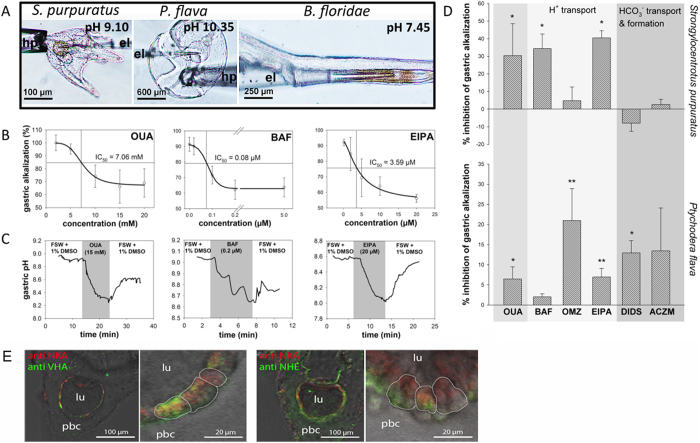Figure 1.
Characterization of the gastric pH regulatory machinery in ambulacrarian larvae. (A) Microelectrode (el) pH measurements in larval digestive systems of the three species indicating highly alkaline digestive systems pluteus (7-15 dpf) and tornaria (10 -20 dpf) larvae and less alkaline conditions in B. floridae larvae (feeding stage 3 dpf). (B) Dose response curves for the inhibition of gastric alkalization in pluteus larvae were determined for the inhibitors ouabain (OUA), bafilomycin (BAF) and ethyl-isopropyl amiloride (EIPA) with respective IC50 values. (C) Real time traces of gastric pH during application of inhibitors and 5 mM Na+ solutions (Supplemental material Figure S1) and washout. (D) Effects of inhibitors including OUA, BAF, EIPA, omeprazole (OMZ), 4,4“-diisothiocyanatostilbene-2,2′-disulphonic acid (DIDS) and acetazolamide (ACZM) as well as 0 mM HCO3−, 5 mM Na+ and 0 mM K+ seawater solutions (for raw values including control experiments see Supplemental material Figure S1; n = 5-7) on the gastric alkalization machinery. (E) Immunocytochemical analyses in sea urchin pluteus larvae demonstrate the sub cellular localization of Na+/K+-ATPase (NKA), V-type H+-ATPase (VHA) and Na+/H+-exchanger (NHE3) immunoreactivity in the stomach epithelium of Strongylocentrotus purpuratus plutei. Dotted lines indicate the position of stomach cells. Values are presented as mean ± SE and asterisks denote significant differences (* p < 0.05, ** p < 0.001). holding pipette: hp; lumen:lu; primary body cavity: pbc; stomach: st; oesophagus: oes; intestine: int.

